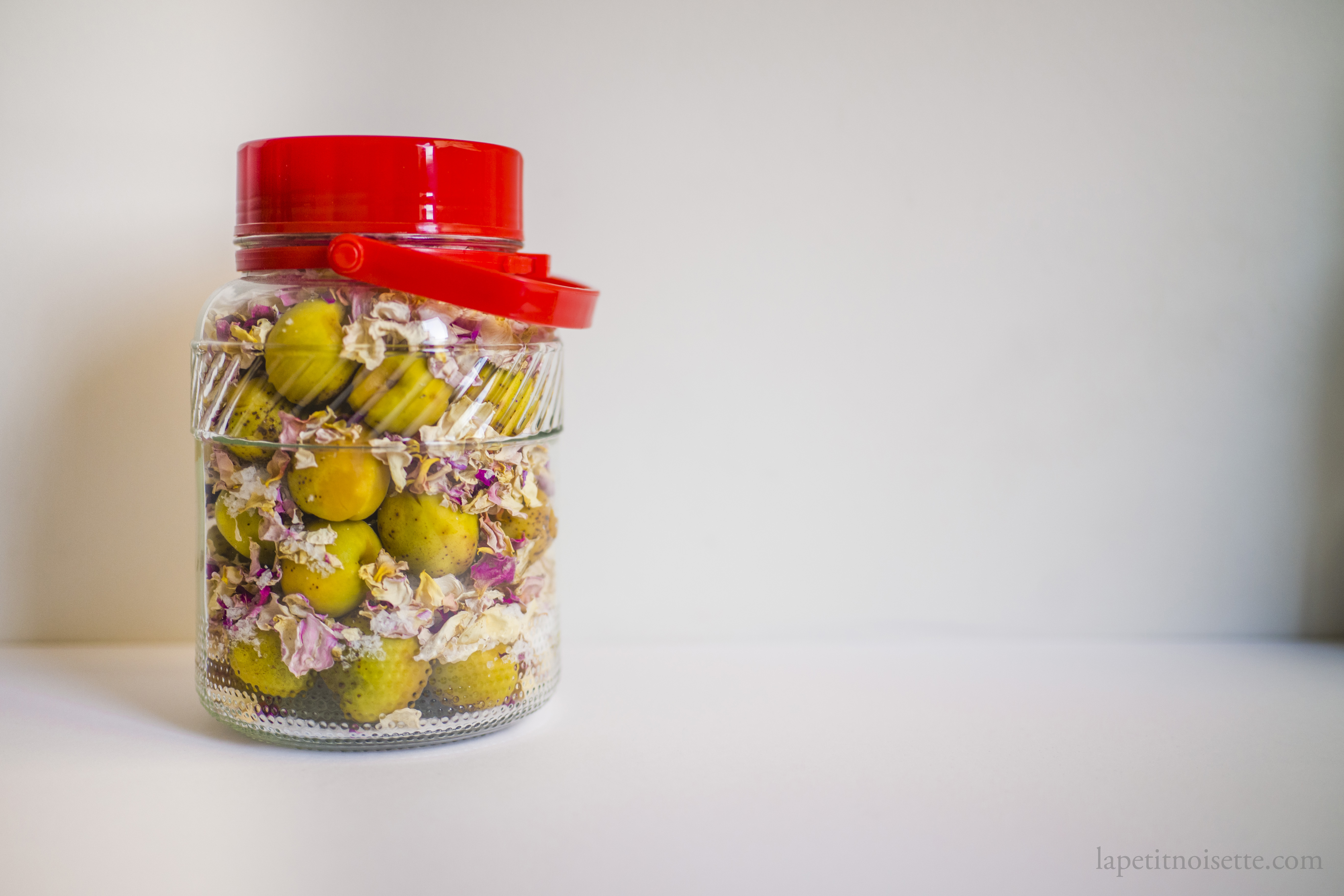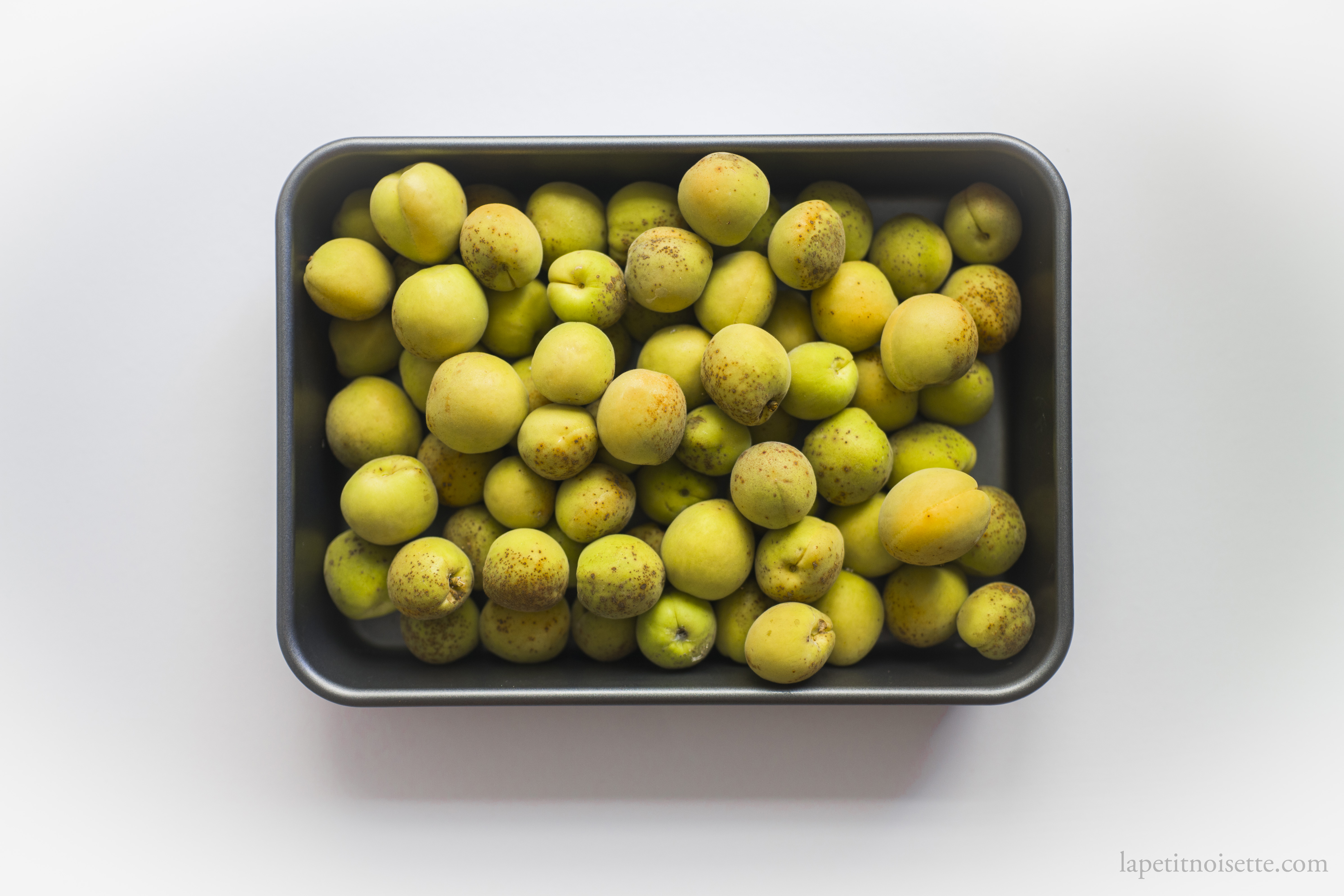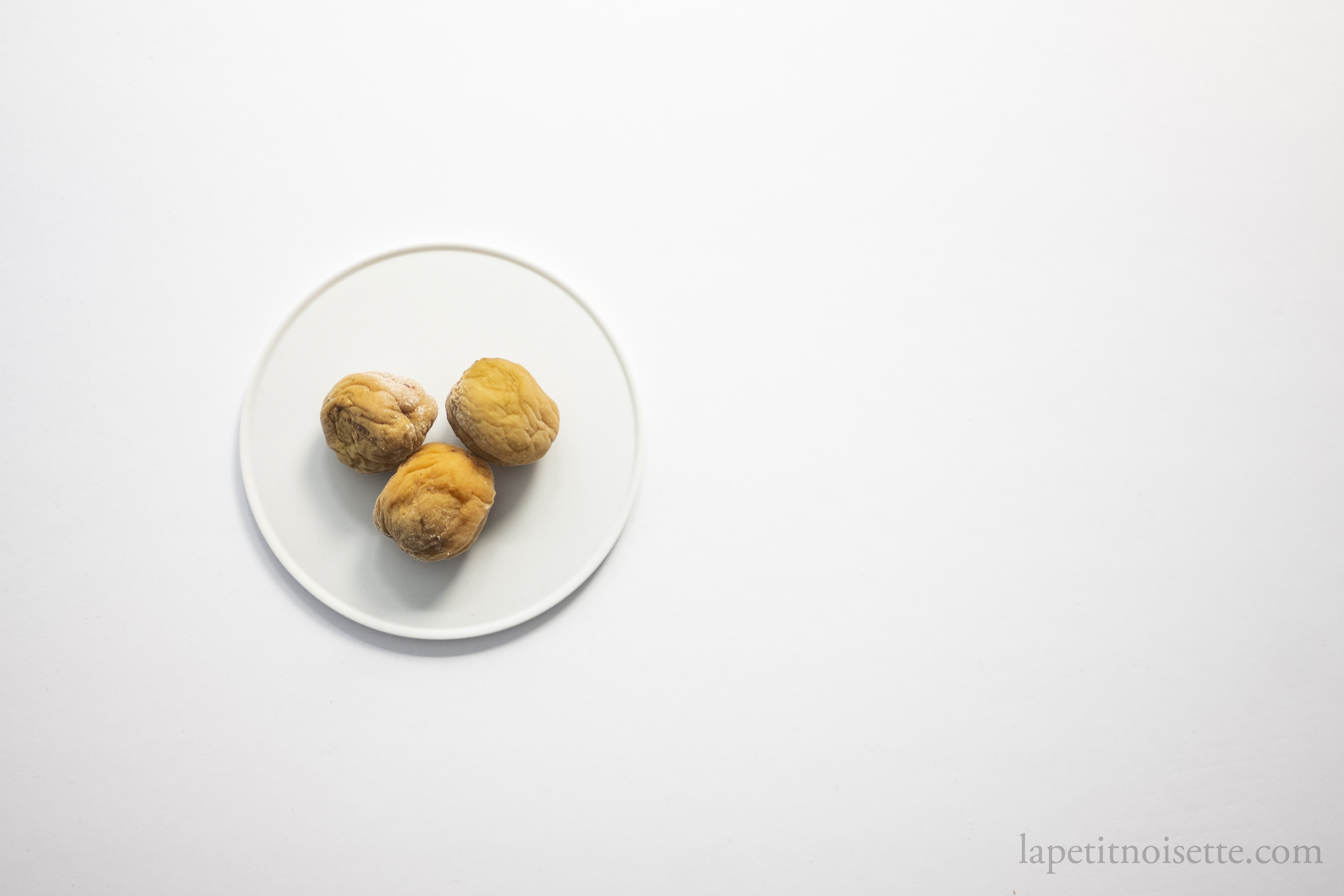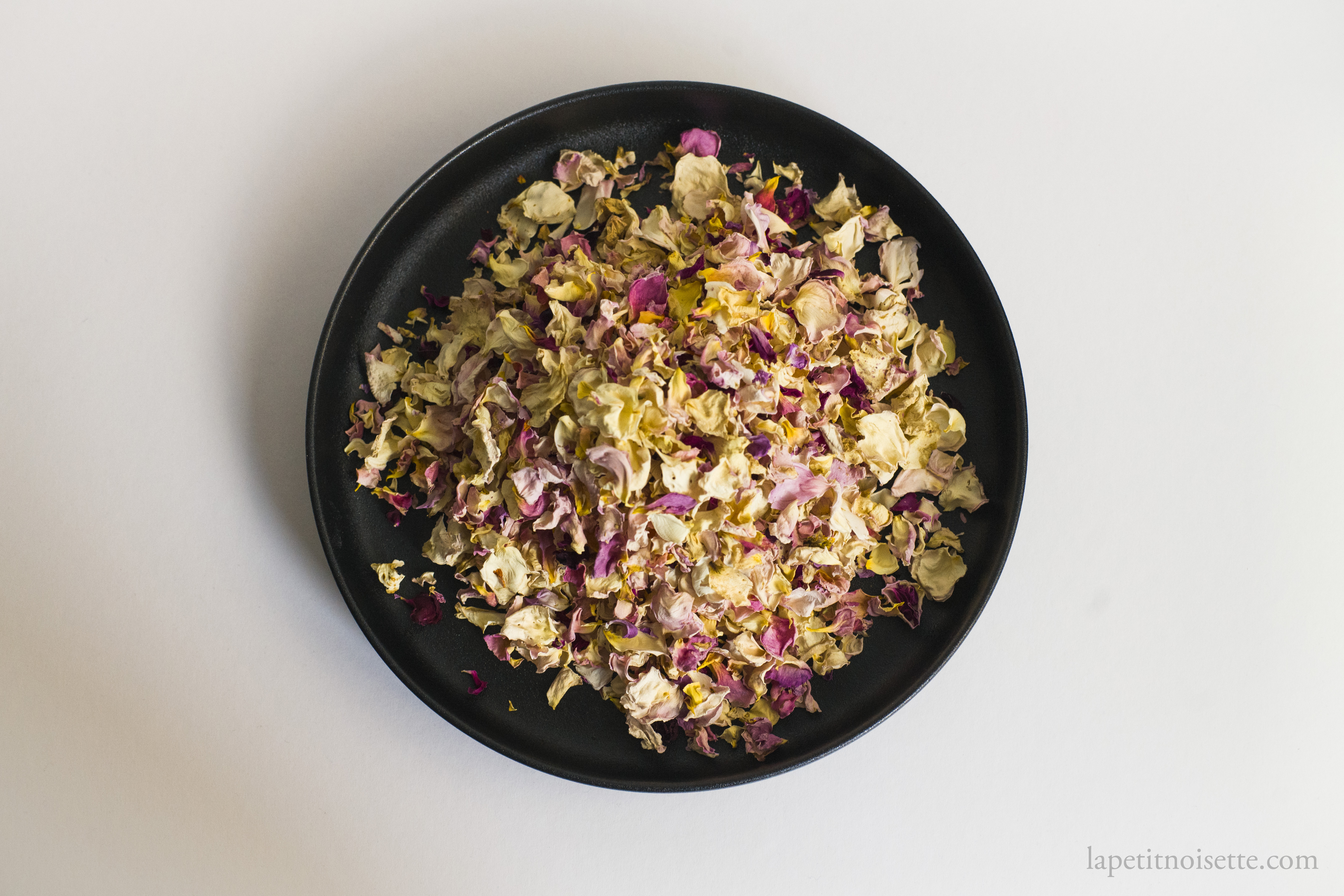
How to make rose scented umeboshi
This article follows on from the science behind lactic acid fermentation that explains all information and method behind this recipe. It is also a deviation of a recipe on basic umeboshi here, which I recommend you read before proceeding.
Within Japan itself, it’s rare to see chefs tamper with traditional recipes using unconventional ingredient combinations or substitutions. However, these are used to great effect by chefs from other parts of the world, from yellow peas miso and chickpea soy sauce to coffee soy sauce. The recipe below is one of these modern recipes for probably the most classic lactic acid fermentation in the Japanese world, umeboshi, or salt preserved plums. Instead of red shiso leaves which are used to colour the umeboshi, rose petals are used as a substitute to gently scent the umeboshi.
This recipe draws its inspiration from the wild roses that were foraged on the beaches in Denmark that were brought back to Noma for various uses such as garnishing dishes or making rose oil. Overall I’d say the flavour pair of Japanese plums and roses were quite a success, though it works better for umeboshi meant to be consumed early rather than umeboshi designed to be aged. Salt-wise, I choose to go with a low 8% as I wanted a more balanced apricot to rose flavour that wasn’t overly salty (Japanese plums are more closely related to apricots than plums).

The same as making normal umeboshi, you’d want to carefully vet and select your plums to remove any with cuts of blemishes which may go mouldy and ruin the whole batch. You’d then want to wash the plums in water, remove any stems and sterilize the plums and jars with alcohol. All this is done to prevent mold growth, and is especially important here with the lower salt percentages.
Any alcohol above 35% proof is good enough to sterilize the plums and bottle. The apricots or plums you use should be firm and unripe. They don’t have to be green specifically, as even yellowish plums work so long as they are unripe, which you can tell from their firmness. You can buy salt specifically for making preserves in Japan but any high quality sea salt works. Avoid iodized salt as it prevents the fermentation from proceeding.

Rose Scented Umeboshi (バラ梅干し)
- Alcohol for sterilizing the jar and plums
- Enough unripe Japanese plums (Ume) to fill your jar of choice (2kg is a good amount to start)
- 8% of the plums’ weight in salt
- 5% of the plums’ weight in fresh rose petals or 2.5% of dried rose petals
- To start, soak the plums in cool water overnight.
- After soaking overnight, one by one, remove the plums from the cool water the next day and remove their stems with either a toothpick or the tip of a paring knife. Take care not to piece or cut the skin of the plums which may lead to mould.
- Once all the stems are removed, wash them plums in water 2 or 3 times.
- Add some alcohol to your fermentation jar/vessel and swish it around to sterilize the jar.
- Pour the alcohol out into a bowl and dunk each plum in the alcohol briefly to sterilize the plums.
- Add a layer of plums into your jar and sprinkle with salt before layering on the rose petals.
- Repeat until all the ingredients are in the jar. Try to sprinkle the salt so that all the salt is distributed evenly in the jar but if a small amount of salt remains just pour it in at the end.
- Cover the plums with muslin cloth and add a weight into the jar to press on the plums that is at least 50-70% of the plum’s weight. Any less and you might not get enough juice and anymore might crush the plums. I just use a doubled bagged ziplock filled with water.
- Cover the jar with another layer of muslin cloth and fasten with string or a rubber band. Alternatively, you can loosely close the lid on the jar.
- After 3 to 4 days you should see the plums start to submerge into their own liquids. Check on the plums every few days to make sure no mould is growing on them but after around a week to a week and a half, the plums should be completely submerged in their liquid. If they aren’t, there should be some undissolved salt that has accumulated at the bottom of the jar. Scoop this salt up onto the top of the unsubmerged plums.
- After 2-3 weeks from the time of initial salting (not from the time the plums are fully submerged) it’s time to sun-dry your plums. Strain them out of the jar and carefully lay them out to dry in a well spaced single layer, making sure there is enough space between each plums for air circulation. The Japanese bamboo strainers work perfectly for this but even a cookie cooling rack works as long as the acidity from the plums don’t cause it to rust.
- You’d also want to dry the rose petals at this point as well in the same way.
- Allow the plums to dry for 3 days (4 days if you live in a humid country) and turn them over once each day to let them dry evenly, especially the underside. You’d want to check the weather forecast to make sure that it won’t rain during those 3 days, even if it means leaving your plums in their juices for a couple days more. The rose petals should dry very quickly so be careful of them being blown away by the wind.
- The plums are now done and are ready to be stored. Rinse each dried plum in their own salted juices (now known as ume vinegar) once before filling them back into the jar. Reserve the vinegar in a different bottle for seasoning.
- Once the jar is filled with the dried plums, cover with the dried rose petals and seal the jar with an airtight lid. You may want to reserve some of the petals to make rose yukari seasoning following the instructions to make shisho yukari.
- The plums are good to eat after drying.

A note on choosing rose petals
If using fresh roses in this recipe, you’ll want to make sure that they’re grown pesticide free and are safe for human consumption. I can assure you that almost all flowers that you can buy at a florist have been sprayed with an ungodly amount of different types of pesticides and fungicides to keep them immaculately pretty. In very small quantities, these chemicals are strong enough to make you sick or even throw up. Therefore, I highly recommend against simply buying roses from a store if they’re not designated for food consumption, unless you either grow them yourself, or you know a spot where you can forage them in the wild. A better alternative is buying dried culinary grade rose petals, which are much easier to find in health stores but can be rather costly. 5% of the plums’ weight in fresh rose petals is what I recommend as the minimum amount for this recipe, but was made as a decision to try and keep the cost of this recipe reasonable. If you have more accessible roses, feel free to experiment with slightly more, or to use rose water as a substitute. Be careful of rose oil even if it’s designated for use in food, as oil can go rancid in fermentations.
Can I use apricots to make this recipe?
Read our article on using apricots to make umeshu for a more in-depth explanation.
Most sources on the internet, including the books by the famous Nancy Singleton state that the recipes for umeshu or umeboshi might be possible with apricots but they are unsure if this is possible. I’ve personally done many tests myself and can say with confidence that these recipes can be accurately replicated with apricots with the caveat that you use unripe apricots, in the same way that the Japanese plums used in this recipe are still in their green/yellowish unripe state. Unless you order from a farmer directly, it’s most likely hard to get green apricots but it is possible to use yellow apricots as long as they’re still very unripe which you can tell from their firmness- they shouldn’t give when lightly squeezed. Ripe apricot will not work as they’ll simply breakdown and go mushy by the end of the brining period.
I cannot thank you enough for sharing your experience with us.